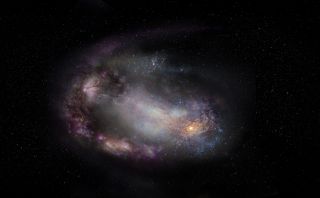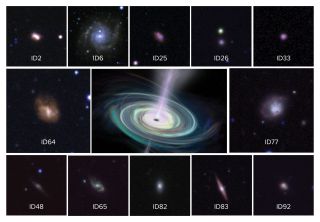Astronomers have detected several supermassive black holes wandering through their dwarf host galaxies, providing new clues about how similar black holes evolved in the early universe.
Using the National Science Foundation’s Karl G. Jansky Very Large Array (VLA) in New Mexico, the researchers identified 13 dwarf galaxies that are less than a billion light-years away from Earth and that host supermassive black holes. Astronomers estimate that these galaxies contain less than 1% of the mass of the Milky Way, making them the smallest galaxies known to host massive black holes, according to a statement.
On average, these supermassive black holes contain about 400,000 times the mass of the sun. And unlike most supermassive black holes that lurk near the center of their galaxy, about half of these objects were found wandering the outskirts instead.
Related: The Strangest Black Holes in the Universe
“We hope that studying them and their galaxies will give us insights into how similar black holes in the early universe formed and then grew, through galactic mergers over billions of years, producing the supermassive black holes we see in larger galaxies today, with masses of many millions or billions of times that of the sun,” Amy Reines, an astrophysicist at Montana State University and lead author on the new research, said in the statement.

The scientists used a galaxy catalog called the NASA-Sloan Atlas to select galaxies of interest, all of which were less than 3 billion times the mass of the sun. Then, they turned to the VLA, which took high-resolution views of 111 of the selected galaxies, revealing that 13 of the galaxies host a massive, active black hole that is consuming surrounding material.
And scientists were particularly interested by the off-center nature of half of these black holes, according to the statement. Those locations suggest the galaxies are the result of past mergers among smaller galaxies.

“This work has taught us that we must broaden our searches for massive black holes in dwarf galaxies beyond their centers to get a more complete understanding of the population and learn what mechanisms helped form the first massive black holes in the early universe,” Reines said in the statement.
The researchers presented their findings on Jan. 7 at the American Astronomical Society meeting in Honolulu. The study will also be published in the Astrophysical Journal. You can read the paper on the preprint site arXiv.org.
Follow Samantha Mathewson @Sam_Ashley13. Follow us on Twitter @Spacedotcom and on Facebook.






